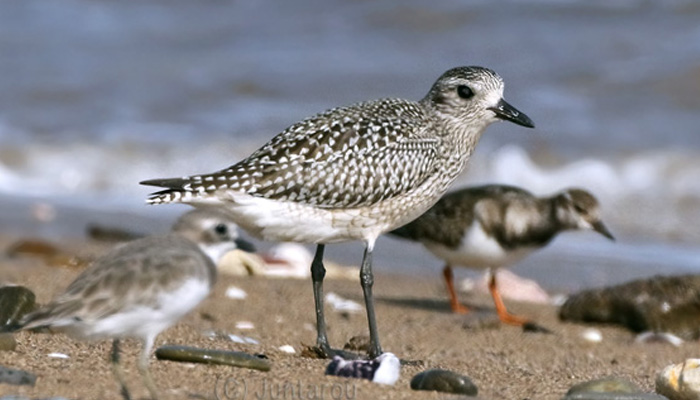
English:
Grey Plover,
Black-billed Plover
Russian: Тулес
Mongolian:
Буурал
сүвээцагаан
German:
Kiebitzregenpfeifer
French: Pluvier argente
Japanese: ダイゼン
(Daizen)
Body length: 19-22 cm
Wing span: 56-63 cm
Breeds
in high Arctic on tundra, where adults spend Jun-Jul, then migrates to W
Europe, where some stop to moult, and even stay through winter (mostly ♂♂),
whereas a majority pass through to winter in W Africa (mostly ♀♀ in tropical
Africa); juveniles migrate c.1 months later (late Aug-Sep) than adults in
autumn. On
autumn migration seen on coastline, often singles or a few birds only, loosely
spread out along shore or on shingle bank, behavior poised (even sluggish). In
winter frequents tidal flats and adjacent freshwater pools, can be seen in
large gatherings at high tide. In spring crosses N Europe in one or two long
legs in May, usually passing unnoticed at great height in fair weather, but in
cold, adverse conditions large, dense flocks can sometimes be seen resting.
Foot mainly marine worms, molluscs and crustaceans.
Identification:
Distinctively big plover with bulky body, large head and heavy bill; posture
more hunched and feeding action more ponderous than with smaller plovers. In
flight, black axillaries diagnostic, bold white wing-bar and whitish rump
characteristic.
- Adult summer: ♂ has solid black below, ♀has white intermixed.
- Adult winter: Underparts whitish, and grey upperpart feathers and wing-coverts
diffusely fringed or barred whitish.
- Juvenile: Greyish-black upperparts and
wing-coverts neatly spotted and notched yellowish-buff; underparts pale
yellowish-buff with fine grey streaking; black ‘armpits’ distinctive in flight;
general coloration often yellowish-brown, recalling juvenile Golden Plover and
since it has a well-marked pale supercilium and often a hint of a dark ear
patch it may even resemble an American Golden Plover.
- 1st summer: Like adult
winter or with very little black below. Many stay though summer in W Europe and
W Africa.